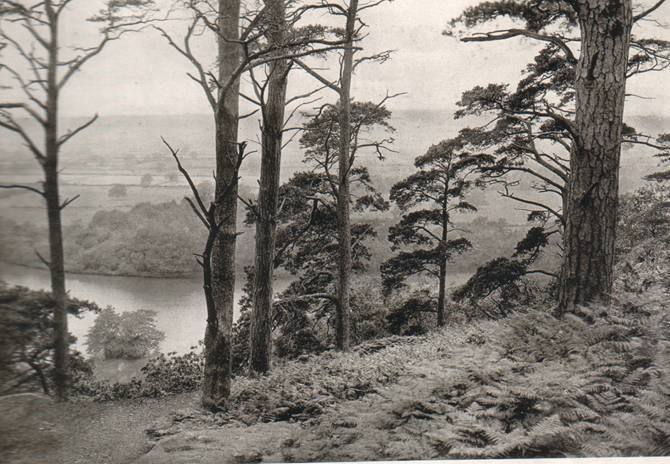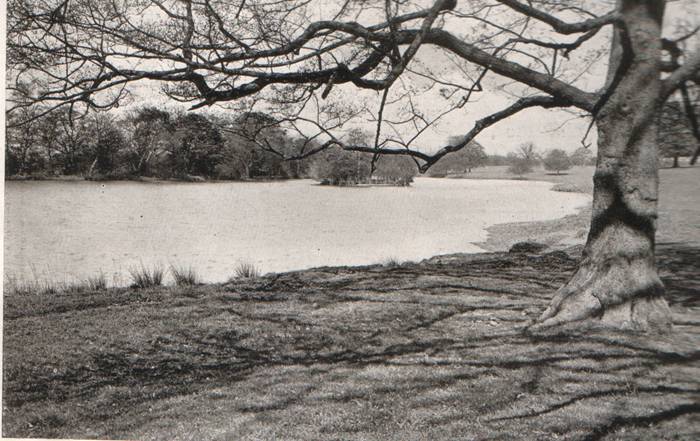
Wem Angling Club
BACK IN THE DAY .......
A COLLECTION OF MEMORIES AND TALES FROM THE GOOD OLD DAYS!

DE-SILTING HAWL LAKE
A great deal has been said by our detractors concerning the wisdom of de-silting Hawkstone Lake. Much of what they say concerns the actual amount of silt present and the eventual depths which might be achieved by removing this. Having lived either at or near Hawkstone for all of my life so remember the days when the first bay, as was most of the lake, was well over six feet deep, and a three tier diving board sited in monastery bay was used by the monks to dive from the top tier into nine feet of water, the two photographs copied here which were taken with a Brownie Box camera in the late forties, may be of interest.
This photo was taken from near the Hermits cave at the top of Grotto hill and shows the first bay as it was then. Note the position of the island, now incorporated into the golf course, which in those days we used to swim out to.
Hidden by the hill is Mr Johncocks boat house which included a long wooden jetty jutting out into the lake. To this were tied the numerous rowing boats, each one fitted with a wrought iron seat on which the ladies sat while their men folk rowed them up and down the lake. There were also punts for hire to be used by fishermen. Boats cost one shilling per hour to hire and, particularly on Sundays, there was often a queue of people awaiting their turn. Mr Johncocks hated pike because they ate the baby ducklings which hatched on the lake so used to stalk them using a punt, shoot them with a twelve bore then hang their bodies from a tree on the other side of the lake. Many of these would have weighed in double figures. The boathouse, jetty, and many of the boats were destroyed by fire some years later.
Particularly note the position of the trees on the far bank, many of whose roots were in the water. The path running along the bank was also only just above the then water level giving an additional three or four feet of depth above what it is now. There were neither any carp or bream in the lake at that time.
MIKE WILLIAMS

This photograph was taken from the point where the golf course ends ( the tenth green) and shows Monastery Bay as it was in the early 1940‘s. In the second inlet but hidden by the tree, was a three stage diving board used by the monks from the monastery. On the golf course side of the lake in what is now known as the first bay was a large boathouse and tea shop owned and run by Mr Johncocks who hired out punts and rowing boats which he kept tied to a wooden jetty sticking out into the lake. Boats were hired by the hour or half day and it was common practice to row leisurely up the lake, around the island in monastery bay and back again, a journey taking about an hour. The boathouse, jetty and most of the boats were destroyed by fire in the late forties.
Many of his customers were American Soldiers and their girlfriends ( at one time several ‘camp followers’ lived rough in the grotto caves) who were stationed at the huge American camp which was sited on a part of the park which is now the golf course. The hotel had been commandeered and became their headquarters and living quarters for officers.
Note the fact that there are no trees on this side of the lake, the banks being clear so that the grassy park land ran right down to the lake side. Note also how the water level on the far side reached almost to the base of the trees (the banks were much higher then ) giving the lake a greater overall depth. I have no idea when or why the island was removed but are sure it was still there in 1953 when I joined the navy.
Some distance around the bend from the island there was an iron footbridge which spanned the lake which led to what was then known as Ralph’s end. Mr Ralphs hired out punts to anglers and it was not uncommon for huge bags of very large tench to be taken in a single sitting. As a boy I actually witnessed two anglers who, having borrowed a stack sheet from Mr R, laid out more than sixty large tench on it to be photographed.
The parkland running down to the lake belonged to the monastery and was kept low from grazing hundreds of sheep on it. It was a closed order of Monks at that time so in theory we had no contact with them although in actual fact we often shared their diving board with them when swimming in the lake.
MIKE WILLIAMS